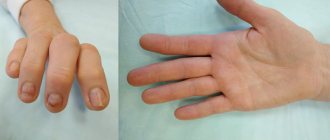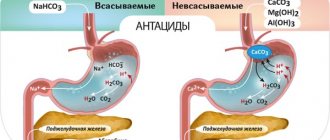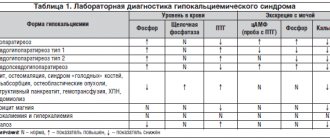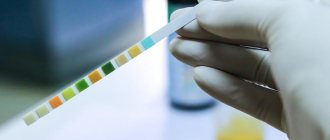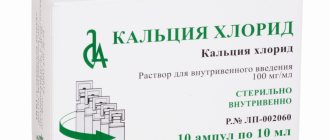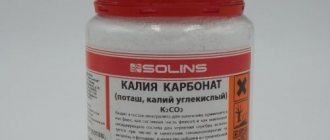Compound
One tablet may contain 250 or 500 mg of active substance.
Auxiliary components: potato starch, anhydrous silicon dioxide in colloidal form, calcium stearate.
The concentration of the active substance in 1 ml of solution is 95.5 mg. 1 ml of the drug contains 8.95 mg of total calcium (Ca2+), which in terms of the theoretical content of calcium gluconate is 100 mg/ml. The solution contains calcium sucrose and water as auxiliary components.
What is Calcium Gluconate?
Medicinal mineral concentrate replenishes the lack of calcium ions, promotes the regulation of metabolism, and participates in many physiological processes. The drug is produced in several forms:
- non-coated white tablets: in dosages of 250 and 500 mg;
- chewable lozenges;
- aqueous solution for parenteral administration in ampoules: with 100 mg of active substance in 1 ml.
Among the auxiliary compounds of the drug: silicon dioxide, starch and other form-building additives. The solution additionally contains calcium sucrose.
Pharmacodynamics and pharmacokinetics
Calcium gluconate - what is it?
Calcium gluconate is a mineral supplement that is used to treat conditions caused by calcium deficiency in the body. The calcium content in the preparation is 9%. The INN (Calcium gluconate) was assigned to the active substance based on data from the European Pharmacopoeia (Ph.Eur.).
the myocardium cannot function normally , contraction of smooth and skeletal muscles, and blood clotting processes; Without them, bone tissue cannot form normally, and other organs and systems cannot function.
The gross formula of calcium gluconate is C12H22CaO14.
Pharmacodynamics
In many diseases, the concentration of Ca ions in the blood decreases; at the same time, severe calcium deficiency contributes to the development of tetany. The drug not only prevents the occurrence of hypocalcemia , but also reduces the permeability of vascular walls, relieves inflammation, has an antiallergic and hemostatic effect , and reduces exudation.
Ca ions are a plastic material for teeth and skeleton; many enzymatic processes occur with their participation; they are responsible for regulating the permeability of cell membranes and the speed of transmission of nerve impulses.
They are needed for the process of neuromuscular transmission and maintaining the contractile function of the heart muscle. If we compare calcium gluconate with calcium chloride, the latter has a more pronounced local irritating effect.
Pharmacokinetics
When taken orally, the substance is partially absorbed, mainly in the small intestine. TCmax - 1.2-1.3 hours. T1/2 of ionized Ca from blood plasma - from 6.8 to 7.2 hours. Penetrates into breast milk and through the placental barrier. It is excreted from the body mainly by the kidneys, but also with the contents of the intestines.
What is Calcium Gluconate good for?
Mineral ions ensure the functioning of muscle tissue, bone restoration, and hematopoiesis. Calcium Gluconate has a systemic effect, regulating metabolic processes and the functioning of internal organs. The drug has a hemostatic, anti-allergenic effect, reduces the intensity of inflammation, stabilizes the permeability of cell membranes, helps prevent swelling, supports heart function, and strengthens tooth enamel.
Calcium gluconate is non-toxic, absorbed into the blood in the small intestine, and penetrates fluids and tissues. Excess ionized substance is filtered by the kidneys and excreted in the urine.
Indications for use of Calcium gluconate
What is Calcium Gluconate tablets for?
Tablets are recommended for conditions accompanied by hypocalcemia, increased permeability of cell membranes, and disturbances in the conduction of nerve impulses in muscle tissue.
Doctors answer the question “what is calcium gluconate used for?” answer that the use of the drug is advisable for:
- hypoparathyroidism ( osteoporosis , latent tetany);
- vitamin D metabolism ( spasmophilia , rickets , osteomalacia );
- hyperphosphatemia in patients with chronic renal failure;
- increased need for Ca ( pregnancy , breastfeeding , periods of intensive growth in children/adolescents);
- insufficient Ca content in the diet;
- bone fractures;
- Ca metabolism disorders in the postmenopausal period;
- conditions that are accompanied by increased excretion of Ca (chronic diarrhea , prolonged bed rest; long-term treatment with diuretics , corticosteroids or antiepileptic drugs );
- poisoning with oxalic acid, Mg salts, soluble salts of fluoric acid (the advisability of using the product as an antidote is due to the fact that, interacting with these substances, Ca gluconate forms non-toxic Ca oxalate and Ca fluoride).
As an addition to the main treatment, calcium gluconate tablets are used as an allergy remedy for itchy dermatoses , febrile syndrome , urticaria , serum sickness , angioedema ; for bleeding of various origins, nutritional dystrophy , bronchial asthma , pulmonary tuberculosis , hepatitis , eclampsia , nephritis , toxic liver damage .
Why are calcium gluconate injections used?
Calcium gluconate in ampoules is prescribed for certain pathologies of the parathyroid glands , conditions that are accompanied by increased excretion of Ca from the body, as an adjuvant for allergies , as well as for allergic complications of treatment with other drugs, to reduce vascular permeability in various types of pathological processes, for nephritis , eclampsia , liver intoxication , hyperkalemia , parenchymal hepatitis , hyperkalemic form of periodic paralysis ( paroxysmal myoplegia ), as a hemostatic agent.
Indications (intravenously/intramuscularly) for administration of the drug are also poisoning with soluble salts of fluoric acid, oxalic acid or Mg salts, for skin diseases ( psoriasis, itching, eczema ).
In some cases, Calcium gluconate is used during autohemotherapy . This method of treatment has proven itself well for skin diseases, furunculosis , recurrent colds , diabetes , rheumatism , allergies , and during the recovery period after serious illnesses.
10 ml of calcium gluconate solution is injected into the patient's vein, and then blood is immediately taken from the vein and transferred back in the form of a subcutaneous injection or injection into the gluteal muscle.
What is a hot shot?
Injections of the drug are also known as “hot injections of calcium gluconate.” In fact, the solution is administered heated only to body temperature.
A hot injection is called a hot injection because of the subjective sensations that arise in the patient: after the injection, there is usually a feeling of warmth spreading throughout the body, and sometimes a fairly strong burning sensation.
Calcium gluconate for allergies
Doctors have proven that one of the causes of allergies may be a severe calcium deficiency in the body. It is with Ca deficiency that most allergic reactions in children are associated: the child’s body grows very rapidly, and as a result, the Ca content in all its tissues decreases.
In addition, factors that contribute to the formation of Ca deficiency are excess vitamin D in the body and teething.
, calcium gluconate is often used as one of the methods for preventing and treating allergies
With sufficient calcium intake into the body, the permeability of the vascular walls decreases, and the penetration of allergens into the systemic bloodstream becomes more difficult. This means that an increase in Ca concentration is accompanied by a decrease in the likelihood of an acute immune reaction.
Calcium gluconate is used in combination with antihistamines . The drug is prescribed, among other things, to eliminate side effects caused by taking other medications.
Studies have shown that, as a source of calcium alone for the body, the calcium salt of gluconic acid is the least active, however, calcium gluconate is best suited allergic diseases
The tablets are taken orally before meals. The dose depends on the characteristics of the disease and the age of the patient.
In addition, in some cases, the patient may be prescribed intravenous administration of the solution. allergies , calcium gluconate is not recommended to be administered intramuscularly or subcutaneously (especially to children).
The course of treatment for allergies usually lasts from 7 to 14 days.
Calcium gluconate for allergies (reviews are eloquent confirmation of this) is a time-tested and quite effective remedy, which, on top of everything, is almost impossible to overdose on.
Maximum absorption of calcium is ensured with the participation of vitamin D , amino acids (in particular L-arginine and lysine) and Ca-binding protein.
Calcium gluconate
Calcium gluconate
(English
calcium gluconate,
lat.
calcii gluconas
) is a calcium salt of gluconic acid, used in medicine for calcium deficiency in the body.
Calcium gluconate is a chemical substance
The gross formula of calcium gluconate is C12H22CaO14. The systematic name is calcium (2 R
,3
S
,4
R
,5
R
)-2,3,4,5,6-pentahydroxyhexanoate. White granular or crystalline powder, odorless and tasteless. Calcium gluconate dissolves quite slowly in cold water, and quickly in boiling water. Practically insoluble in ethanol and ether. Molecular weight 430.373 g/mol. The calcium content in calcium gluconate is 8.9% (which is less than in most other calcium salts used in medicine). In pharmaceuticals, it is often used in the form of calcium gluconate monohydrate, when a water molecule is attached to a calcium gluconate molecule: C12H22CaO14·H2O or the “text” version: (HOCH2(CHOH)4COO)2Ca·H2O.
Calcium gluconate is the international nonproprietary name of the drug
Calcium gluconate is the international nonproprietary name (INN) of the drug. According to the pharmacological index, calcium gluconate is included in the group “Macro- and microelements”. In ATC, calcium gluconate is included in the following sections:
- "A. Drugs affecting the digestive tract and metabolism”, subsection “A12 Mineral Supplements”, group “A12AA Calcium Preparations” and has code A12AA03
- "D. Preparations for the treatment of skin diseases", subsection "D11 Other drugs for the treatment of skin diseases", group "D11AX Other drugs for the treatment of skin diseases" and has the code D11AX03
See also the article “ Calcium as medicine
”.
Indications for use of calcium gluconate
Calcium gluconate is indicated for:
- diseases accompanied by calcium deficiency, increased permeability of cell membranes, disruption of nerve impulses in muscle tissue
- hypoparathyroidism (latent tetany, osteoporosis)
- disorders of vitamin D metabolism: rickets (spasmophilia, osteomalacia), hyperphosphatemia in patients with chronic renal failure.
- conditions that increase the need for calcium: pregnancy, breastfeeding, increased body growth
- insufficient calcium content in food, calcium metabolism disorders (in the postmenopausal period)
- acute inflammatory processes in the oral cavity, accompanied by swelling, the postoperative period (to reduce swelling), remineralizing therapy for the prevention and treatment of caries and non-carious tooth lesions
- increased excretion of calcium during prolonged bed rest, chronic diarrhea, secondary hypocalcemia during prolonged use of diuretics and antiepileptic drugs, glucocorticosteroids
- poisoning with magnesium salts, oxalic and fluoric acids and their soluble salts (when interacting with calcium gluconate, insoluble and non-toxic calcium oxalate and calcium fluoride are formed)
- hypercalcemic form of paroxysmal myoplegia
How to take calcium gluconate
Calcium gluconate is taken:
- The tablets are crushed before taking; taken orally before meals 2-3 times a day in the following dosage:
- adults - 1–3 g or more
- children 10–14 years old – 2–3 years
- children 7–9 years old – 1.5–2 g
- children 5–6 years old – 1–1.5 g
- children 3–4 years old - 1 g
- adults and children over 9 years old - 9 g
- children 7–9 years old – 6 g
- children 5–6 years old - 4.5 g
- 3–4 years – 3 g
- adults intramuscularly or intravenously, administer 5–10 ml of 10% calcium gluconate solution daily, every other day or two days, depending on the indications
- children intravenously, slowly from 1 to 5 ml of 10% calcium gluconate solution every 2-3 days, depending on age.
Side effects when treated with calcium gluconate
Calcium gluconate therapy may be accompanied by the following side effects:
- constipation (when taken orally)
- irritation of the mucous membrane of the gastrointestinal tract (when taken orally)
- nausea, vomiting, diarrhea, bradycardia (with intramuscular or intravenous administration)
- heat or burning in the mouth and throughout the body (with intravenous administration)
- hypercalcemia
Features of calcium gluconate therapy for pregnant and lactating women
Calcium is transported across the human placenta.
Fetal calcium accumulation occurs primarily during the third trimester. By the end of a normal pregnancy, the fetus gains approximately 28 g of calcium and 16 g of phosphorus for skeletal development. The recommended daily calcium supplement for pregnant women averages 1,200 mg (compared to 400 mg per day for an adult not pregnant or lactating). During the last trimester, an additional 250 to 300 mg of calcium per day is recommended. At the same time, the FDA established a risk category for the effect of calcium gluconate on the fetus when used in pregnant women - “C” (animal studies revealed a negative effect of the drug on the fetus, and there were no adequate studies in pregnant women, but there is a potential benefit associated with the use of this drug in pregnant women , may justify its use despite the risks). There is no scientific data on the penetration of calcium into milk from the body of a nursing mother. Calcium is considered a normal nutritional component of human milk. The calcium content in breast milk averages 300 mg per liter. The recommended daily intake of calcium for a woman during lactation is 1200 mg. One liter of cow's milk contains about 1200 mg of calcium.
Pregnant or breastfeeding women who do not consume milk or dairy products may need supplemental calcium.
Medicinal mono- and multicomponent preparations containing calcium gluconate
Calcium gluconate
are approved for use, sometimes with additions such as “
stabilized
”, “
VIAL
”, “
LekT
” and others.
Calcium gluconate is also included in multicomponent preparations:
- anti-cold and anti-flu drugs Anvimax
(calcium gluconate monohydrate + paracetamol + ascorbic acid + rimantadine hydrochloride + rutoside + loratadine),
Antigrippin-Anvi
(
first capsule:
acetylsalicylic acid + ascorbic acid + rutoside and
second capsule:
calcium gluconate monohydrate + metamizole sodium monohydrate + diphenhydramine hydrochloride),
Antigrippin-Maximum
(calcium gluconate monohydrate + paracetamol + rimantadine hydrochloride + ascorbic acid + loratadine + rutoside),
Antigrippin-ARVI - anticonvulsants " Pagluferal
"
-1, 2, 3
(calcium gluconate + bromizal + caffeine + papaverine + phenobarbital) - solution for intracoronary infusion Consol
(calcium gluconate + potassium chloride + lidocaine hydrochloride + magnesium sulfate + sodium bicarbonate + sodium chloride)
and others. On the website in the Literature section there is a subsection “Nutraceuticals”, containing articles that touch upon, among other things, the use of mineral supplements.
Calcium gluconate (solution for intravenous and intramuscular administration; solution for injection; tablets) is included in the “List of vital and essential medicines.”
Calcium gluconate has contraindications, side effects and application features; before use, consultation with a specialist is necessary.
Calcium provocative test to confirm the presence of gastrinoma
In cases where high gastric secretion is observed but serum gastrin levels are between 100 and 1000 pg/ml, the diagnosis of gastrinoma should be confirmed using provocative tests. Tests are performed with secretin, calcium or a standard breakfast. The calcium test is carried out as follows: a 10% solution of calcium gluconate is administered intravenously for 3 hours at a dose of 5 mg Ca/kg/h; gastrin is determined before the administration of calcium and every 30 minutes for 4 hours. A test with calcium is more dangerous for the patient compared to a test with the introduction of secretin, so it is not recommended as a primary test. Zollinger-Ellison syndrome is characterized by a sharp increase in gastrin content after administration of a calcium solution. The secretin test has the greatest diagnostic value. It is positive in 87% of patients with Zollinger-Ellison syndrome. The indication for a calcium test is a negative result of the secretin test (13% of patients with Zollinger-Ellison syndrome). Unfortunately, a calcium test can additionally identify only 4% of patients with gastrinomas. Thus, in 9% of patients with Zollinger–Ellison syndrome, both provocative tests are negative (Okhlobystin A.V.).
Calcium gluconate - food supplement
Calcium gluconate, as a food additive, has code E578 and is characterized by SanPiN 2.3.2.1293-03 as an acidity regulator and hardener. As a supplement E578 calcium gluconate can be added to:
- infant formula
- coffee drinks
- bread and bakery products
- flour confectionery products
Calcium gluconate is used in the production of canned vegetables and fruits as a thickening agent for plant tissues.
In agriculture, calcium gluconate is used in the preparation of animal feed. Back to section
Contraindications
Contraindications to the use of solution and tablets:
- intolerance to the components of the drug;
- severe hypercalciuria ;
- tendency to thrombosis;
- hypercoagulability;
- severe atherosclerosis ;
- calcium nephrourolithiasis;
- increased blood clotting;
- sarcoidosis;
- severe renal failure;
- period of treatment with cardiac glycosides (for example, digitalis preparations).
Side effects
The drug is usually well tolerated, but in some cases the following disorders are possible:
- bradycardia;
- hypercalciuria , hypercalcemia ;
- nausea, vomiting, stool disorders ( constipation /diarrhea), epigastric pain;
- formation of calcium stones in the intestines (with long-term use of high doses of the drug);
- impaired renal function ( swelling of the lower extremities, frequent urination);
- hypersensitivity reactions.
bradycardia , diarrhea, a feeling of heat in the mouth and then throughout the body, and changes in the skin may sometimes be observed These reactions pass quite quickly and do not require special treatment.
sweating , vomiting, arterial hypotension , and collapse (in some situations, lethal) may occur The result of extravasal penetration of the solution can be calcification of soft tissues.
In very rare cases, allergic and anaphylactic reactions .
When calcium gluconate is administered intramuscularly, local irritation and tissue necrosis .
Side effects of calcium gluconate
When used correctly, the product is well tolerated. Occasionally, during treatment the following are possible:
- heart rhythm disturbance;
- dyspepsia, stool disorder;
- pain in the epigastric region;
- with long-term use: formation of stones in the renal pelvis.
After the injection, you may feel intense heat in the area where the solution was administered and hyperhidrosis. Increased blood pressure, skin irritation, formation of calcifications in soft tissues, and physical weakness are likely. In case of overdose, the risk of side effects increases many times over.
Instructions for use of Calcium gluconate
Calcium gluconate tablets, instructions for use
The tablets are taken before meals, after crushing or chewing.
A single dose for patients over 14 years of age is from 1 to 3 g (2-6 tablets for each dose). Patients 3-14 years old are given 2-4 tablets. 2-3 rubles/day.
Treatment lasts from 10 days to 1 month. The duration of the course is determined by the attending physician individually depending on the patient’s condition.
The permissible upper limit of the daily dose for elderly patients is 4 tablets. (2 g).
Ampoules Calcium gluconate, instructions for use
Calcium gluconate is administered intravenously or intramuscularly.
For patients over 14 years of age, injections are given once a day. A single dose is from 5 to 10 ml of solution. Depending on the patient’s condition, injections can be given daily, every other day or once every two days.
For children from birth to 14 years of age, the dose of 10% calcium gluconate solution intravenously varies from 0.1 to 5 ml.
Before administration, the drug should be warmed to body temperature. The medicine should be administered slowly - over 2-3 minutes.
To administer less than one milliliter of solution, it is recommended to dilute a single dose to the required volume (syringe volume) with a 5% glucose solution or 0.9% NaCl solution.
CALCIUM GLUCONATE B. BROWN
Directions for use and doses
Normally, plasma calcium concentration is in the range of 2.25-2.75 mmol/l or 4.5-5.5 meq/l.
Treatment should be aimed at restoring this level. During treatment, it is necessary to carefully monitor the concentration of calcium in the blood serum. Recommended Doses
Adults
The starting dose for adults is usually 10 ml of Calcium gluconate B. Brown, which corresponds to 2.26 mmol or 4.52 mEq of calcium. Depending on the clinical condition of the patient, the drug can be reintroduced. Subsequent doses are determined in accordance with the concentration of calcium in the blood serum.
Children under 18 years old
The dose and route of administration depend on the degree of development of hypocalcemia, the nature and severity of symptoms. For mild neuromuscular symptoms, calcium should be given orally.
The table shows the recommended starting dose values:
| Age | Body weight (kg) | ml | Equivalent to mmol (meq) calcium |
| 3 months | 5,5 | 2-5 | 0,45-1,13 (0,9-2,26) |
| 6 months | 7,5 | 2-5 | 0,45-1,13 (0,9-2,26) |
| 1 year | 10 | 2-5 | 0,45-1,13 (0,9-2,26) |
| 3 years | 14 | 5-10 | 1,13-2,26 (2,26-4,52) |
| 7.5 years | 24 | 5-10 | 1,13-2,26 (2,26-4,52) |
| 12 years | 38 | 5-10 | 1,13-2,26 (2,26-4,52) |
| > 12 years | >38 | as for adults |
This corresponds approximately to:
- 0.4-1 ml/kg body weight (corresponding to 0.09-0.23 mmol [0.18-0.45 meq] calcium per kg body weight) for children under 3 years of age;
- 0.2-0.5 ml/kg body weight (corresponding to 0.05-0.1 mmol [0.1-0.2 meq] calcium per kg body weight) for children from 4 to 12 years
.
For patients over 12 years of age
adult doses are applicable.
In cases of severe symptoms of hypocalcemia, for example, symptoms from the cardiovascular system, higher initial doses (up to 2 ml/kg body weight, corresponding to 0.45 mmol) may be necessary to quickly restore normal serum calcium levels [0. 9 mEq] calcium/kg body weight).
Also, depending on the clinical condition of the patient, the drug may be re-administered. Subsequent doses are determined in accordance with the concentration of calcium in the blood serum.
If necessary, for example, with a lack of calciferol, oral calcium should be taken after intravenous administration.
Elderly patients
Although there is no evidence that calcium gluconate tolerance is directly affected by advancing age, age-related features that are associated with aging, such as renal dysfunction and slow metabolism, may indirectly affect tolerance and may require dosage reduction.
Method of administration
Adults
Slow intravenous or deep intramuscular injection.
Children under 18 years old
Only slow intravenous injection or intravenous infusion after dilution, in order to achieve sufficiently low rates of administration and to eliminate the possibility of local irritation or necrosis in the event of accidental release of the drug into perivascular tissues. For intravenous infusion, Calcium gluconate B. Brown can be diluted in a ratio of 1:10 to a concentration of 10 mg/ml with the following solutions for infusion: 0.9% sodium chloride solution or 5% glucose solution.
Children should not administer the drug intramuscularly.
The rate of intravenous administration should not exceed 50 mg of calcium gluconate/min. The patient should remain in a supine position and be closely monitored during the injection. Monitoring should include heart rate or ECG.
Due to the risk of local irritation, intramuscular injections should only be performed if intravenous injection is not possible. Intramuscular injections must be done deep enough into the muscle, preferably in the gluteal region.
For obese patients, a longer needle should be selected to ensure safe insertion into muscle rather than fat tissue.
If repeated injections are necessary, the injection site should be changed each time.
Overdose
With long-term treatment with high doses of calcium gluconate, the risk of developing hypercalcemia with the deposition of Ca salts in the body increases. The likelihood of hypercalcemia increases with the simultaneous use of high doses of vitamin D or its derivatives.
Hypercalcemia manifests itself:
- anorexia;
- constipation;
- nausea/vomiting;
- irritability;
- increased fatigue;
- polyuria;
- abdominal pain;
- polydipsia;
- muscle weakness;
- arterial hypertension;
- arthralgia;
- mental disorders;
- kidney stones;
- nephrocalcinosis.
In severe cases, coma and cardiac arrhythmia .
To eliminate the symptoms of overdose, the drug should be discontinued. In severe cases, the patient is prescribed intravenous calcitonin at a rate of 5-10 MO/kg/day. The product is diluted in 0.5 liters of 0.9% NaCl solution and administered dropwise over six hours. Slow drip administration of the antidote 2-4 times a day is also allowed.
What are calcium gluconate tablets used for?
They are prescribed for suspected development of hypocalcemia, for its prevention, for various metabolic disorders, intoxication and injuries:
- osteoporosis;
- hyperphosphatemia;
- calcium deficiency and its increased costs: during pregnancy, menopause;
- to accelerate bone regeneration after fractures;
- poisoning with salts of heavy metals, chemicals;
- with long-term treatment with diuretics, laxatives;
- with malnutrition: lack of foods containing calcium.
As an additional therapy, the drug is recommended for skin allergies, tuberculosis, liver damage, bronchial asthma, and nephritis.
Interaction
A drug:
- slows down the absorption of etidronate , estramustine , bisphosphonates , tetracycline antibiotics , quinolones , fluoride and iron preparations for oral administration (an interval of at least 3 hours should be maintained between their doses).
- reduces the bioavailability of phenytoin ;
- enhances the cardiotoxicity of cardiac glycosides ;
- in patients with hypercalcemia , it reduces the effectiveness of calcitonin ;
- reduces the effects of calcium channel blockers;
- increases the toxicity of quinidine .
In combination with quinidine, it provokes a slowdown in intraventricular conduction; in combination with thiazide diuretics hypercalcemia increases . Vitamin D and its derivatives help increase calcium absorption. Cholestyramine reduces Ca absorption in the gastrointestinal tract.
Forms insoluble or slightly soluble Ca salts with salicylates, carbonates, and sulfates.
Certain foods (for example, rhubarb, bran, spinach, cereals) can reduce the absorption of Ca from the digestive tract.
Not compatible with the solution:
- carbonates;
- sulfates;
- salicylates;
- ethanol.
special instructions
Due to the possibility of developing necrosis, calcium gluconate should be administered exclusively intravenously to children under 14 years of age.
Before filling the syringe, ensure that there is no residual alcohol in it (a sediment may form).
Treatment of patients with of urolithiasis , reduced glomerular filtration rate or mild hypercalciuria should be carried out under the control of Ca2+ levels in the urine. To reduce the risk of developing urolithiasis, it is recommended to drink enough fluids.
“Pharaoh's snake” from calcium gluconate
Calcium gluconate tablets are often used by enthusiastic chemists to produce “pharaoh’s snake,” a porous product that is formed from a small amount of reacting substances.
The tablet is placed on dry fuel, and then the fuel is set on fire. A light gray “snake” with white spots begins to crawl out of the tablet. Moreover, the volume of the “pharaoh snake” significantly exceeds the volume of the original substance: for example, in some experiments, snakes 10-15 cm long were obtained from 1 tablet.
During the decomposition of calcium gluconate, Ca oxide, carbon dioxide, carbon and water are formed. The characteristic shade of the resulting snake is given by Ca oxide. The only drawback of such a “pharaoh snake” is its fragility; it crumbles very easily.
Analogs
Level 4 ATC code matches:
Calcium Sandoz Forte
Calcium glycerophosphate
Calcium gluconate-Vial , LekT , B. Brown ; Additive calcium , Hydroxyapatite , Glycerophosphate granules , Calcium lactate , CalViv , Calcium pangamate , Calcium-Sandoz .
Calcium gluconate for children
Why is calcium gluconate prescribed to children?
In the articles, Dr. Komarovsky notes that the most common indications for the use of the drug in pediatrics are conditions caused by insufficient intake of calcium into the body from food, as well as conditions caused by impaired absorption of calcium in the intestine.
Hypovitaminosis D to the development of hypocalcemia , along with a reduced content of Ca in food . In addition, certain diseases of the parathyroid glands and thyroid gland hypocalcemia .
In addition to these diseases and rickets , indications for prescribing Ca drugs for children are allergic diseases (acute or chronic), skin diseases, pathologies manifested by blood clotting disorders, physiological conditions that are accompanied by an increase in the child’s body’s need for Ca (periods of active growth).
How to take Calcium Gluconate correctly?
For children, Komarovsky recommends dosing calcium gluconate depending on age. In the first 12 months of a child’s life, the standards for daily Ca intake range from 0.21 to 0.27 g. Children under 3 years of age require 0.5 g of Ca per day, children 4-8 years old - 0.8 g, children over eight years of age - 1-1.3 g.
As a rule, children get Ca from dairy products, greens, fruits, vegetables and nuts.
Children under 12 months are given 3 tablets per day (1.5 g), children under 4 years old - 6 tablets per day (3 g), children under 9 years old - depending on the severity of calcium deficiency and the characteristics of the clinical situation - 6-12 tablets. day (3-6 g), children under 14 years old - 12-18 per day (6-9 g).
The daily dose is divided into 2-4 doses.
The drug is usually administered intravenously to children as an emergency treatment: for bleeding, convulsions, acute allergic reactions.
The solution is not administered subcutaneously or intramuscularly to children. Medicine can only be injected into the muscle in adult patients!
When are calcium gluconate injections given?
Among the indications for the course of injections of the drug:
- pathologies of the parathyroid glands;
- allergic complications;
- liver intoxication;
- hyperkalemia;
- psoriasis;
- eczema;
- diabetes;
- rheumatism.
The solution is administered intravenously and intramuscularly once a day. If necessary, the product is diluted in saline and heated to +35°C.
Single dose: 5–10 ml of the drug. For children from the first days of life and adolescents under 14 years of age, the medicine is administered intravenously. The dose is calculated from 0.1 to 5 ml.
The treatment regimen involves daily injections or 2-3 injections per week.
Reviews of Calcium gluconate
The most common reviews of the drug Calcium Gluconate are reviews for allergies . The drug is prescribed to both adults and very young children. At the same time, most people consider it a worthy alternative to more expensive and advertised medications.
To compensate for calcium deficiency, tablets are usually prescribed, but in some situations the drug is administered intravenously or into a muscle.
Reviews of calcium gluconate injections intramuscularly suggest that the procedure is quite painful. Moreover, unpleasant sensations usually occur not during the injection, but after it.
Reviews about calcium gluconate intramuscularly indicate that intravenous injections are tolerated somewhat easier than injections into the muscle. However, it should be remembered that the injection is “hot”, and after it you should not stand up suddenly.
Despite the pain of injections, the drug helps well with allergies , pityriasis rosea , heavy periods, persistent sore throat , herpes and a number of other pathologies. In pregnant women, after treatment with calcium gluconate, leg cramps are significantly reduced, nails and teeth are strengthened.
However, you should not forget that the product is a medical drug, so only a doctor can recommend treatment for it.
Calcium gluconate price
The price of Calcium gluconate tablets in Russian pharmacies is from 3.5 rubles. for 10 pieces. The cost of package No. 30 is 40-45 rubles. In Ukraine you can buy 10 tablets from 3.85 UAH.
A 10% solution in Ukrainian pharmacies costs from 17 UAH (5 ml ampoules, No. 10). The price of an ampoule of 5 ml (No. 1) is 1.8 UAH. In Russia, the price of Calcium gluconate injections is from 118 rubles.
- Online pharmacies in RussiaRussia
- Online pharmacies in UkraineUkraine
- Online pharmacies in KazakhstanKazakhstan
ZdravCity
- Calcium gluconate tablets 500 mg 30 pcs. AO Update PFK
45 rub. order - Calcium gluconate tablets 500 mg 40 pcs JSC "PFK Obnovlenye"
57 RUR order
- Calcium gluconate B. Brown solution for intravenous and intramuscular injection. 100 mg/ml 10 ml 20 pcs. B. Braun Melsungen AG
RUR 378 order
- Calcium gluconate tablets 500 mg 20 pcs Pharmstandard-Leksredstva OJSC
31 rub. order
- Calcium gluconate-SOLOpharm solution for IV and IM 100 mg/ml (amp) 5 ml 10 pcs. Grotex LLC
102 RUR order
Pharmacy Dialogue
- Calcium Gluconate tablets 500 mg No. 20 Square C
32 RUR order
- Calcium gluconate (amp. 10% 10ml No. 10)North China Pharma
109 rub. order
- Calcium Gluconate tablets 500 mg No. 10 Square C
20 rub. order
- Calcium gluconate (table 500 mg No. 40)Update of PFC JSC
63 RUR order
- Calcium gluconate-SOLOpharm (amp. 10% 10ml No. 10)Grotex LLC
175 rub. order
show more
Pharmacy24
- Calcium gluconate 10% 5 ml No. 10 solution PAT "Farmak", Ukraine
28 UAH. order - Calcium gluconate-Darnitsa 10% 5 ml No. 10 injection solution PrAT” Pharmaceutical company “Darnitsa”, Ukraine
29 UAH order
- Calcium gluconate 0.5 No. 10 tablets PAT "Kiivmedpreparat", Ukraine/PAT "Galichfarm", Ukraine
6 UAH order
- Calcium gluconate 0.5 N10 tablets PAT "Lubnipharm", Ukraine
2 UAH order
- Calcium gluconate 10% 10 ml No. 10 solution PAT "Farmak", Ukraine
45 UAH order
PaniPharmacy
- Calcium gluconate stabil. solution d/in. 10% amp. 5ml No. 10 Ukraine, Darnitsa
34 UAH order
- Calcium gluconate solution d/in. 10% amp. 5ml No. 10 Ukraine, Darnitsa ChAO
15 UAH order
- Calcium gluconate tab. 0.5g No. 10 Ukraine , Health
4 UAH order
- Calcium gluconate tab. 0.5g No. 10 Ukraine, Lubnyfarm
3 UAH order
- Calcium gluconate stabilized. solution d/in. 100mg/1ml 5 ml No. 10 Ukraine, Farmak OJSC
23 UAH order
show more

